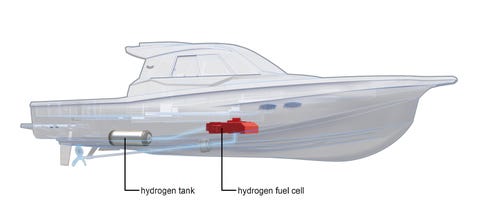Yanmar to Develop a Hydrogen Fuel-cell System for Maritime Applications
by Rudy P. SysAdmin at howtofindthemoneyOne of the most obvious effects of climate change is a rise in sea levels. So it makes sense that at least some oceangoing vessels are being developed that won't contribute carbon dioxide to the atmosphere and thus raise those levels even further. You can find one example of green boat technology hidden in the hull of a new boat from Yanmar Holdings. The boat's hydrogen-powered fuel-cell system uses parts from the powertrain in the Toyota Mirai.
Yanmar announced its new boat as part of a memorandum of understanding the company has signed with Toyota. The mission is to "develop a hydrogen fuel-cell system for maritime applications." Toyota's contribution includes the high-pressure hydrogen tanks used in the Mirai. Yanmar wants to create a H2 powertrain that is easy to install and has "superior cruising range." That sounds familiar.
Yanmar said it hopes to install this maritime fuel-cell system on its own boat so it can start field demonstration tests by the end of the 2020 fiscal year, then expand the hydrogen technology "for a variety of applications and deployments."

This is not Yanmar's first foray into hydrogen-powered boats. In 2018, the company partnered with Toyota Tsusho, a member of the Toyota Group, and Ballard Power Systems to field test a 16.5-meter, H2-powered boat called Shimpo. The boat used a 60-kW hydrogen fuel-cell system and a 60.0-kWh lithium-ion battery system developed by the Uzushio Electric Company. The project was part of Japan's Ministry of Land, Infrastructure, Transport and Tourism's 2015 project to create a hydrogen-based society. Yanmar said in 2018 that one potential market for its first hydrogen vessels could be tour boats that operate in urban waterways and that it will "continue to cooperate with government, industry and academia on development of hydrogen fuel cell-powered boats and ships." This year, it said, its lower-greenhouse-gas boats are in line with the International Maritime Organization's strategy to bring boat greenhouse-gas emissions to zero by the end of the century.
Earlier this year, Toyota said that a maritime version of the Mirai's powertrain would be used in the Energy Observer, a 31-meter renewable-energy oceangoing vessel that can make its own hydrogen onboard using seawater. Adapting the fuel cell system to work on the water took only seven months at the Toyota Technical Center Europe and required a system redesign to reduce the size of the system.
Toyota started thinking about building boats in 1989. The automaker opened its Marine Business Planning Office to work on pleasure craft in 1990 and started selling its Ponam-28 in 1998. Other Toyota boats, including the Ponam-37 and the Epic X22, went on sale after that, and in 2016, Toyota announced its new Ponam-28V premium sports cruiser watercraft developed in partnership with Yanmar.
The 10 largest coal producers and exporters in Indonesia:
Source: Car and Driver
Sponsor Ads
Created on Jun 20th 2020 20:09. Viewed 636 times.
Comments
No comment, be the first to comment.



